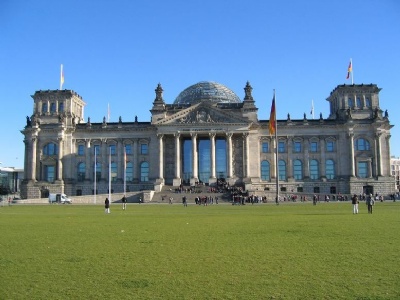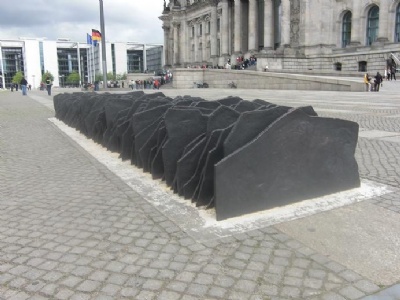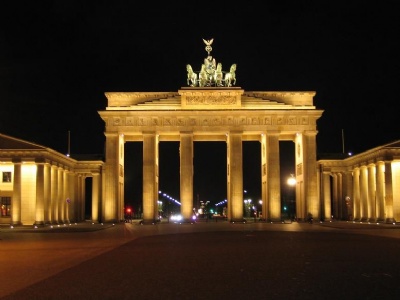Berlin – Reichstag
On February 27, 1933, the Reichstag (Parliament) in Berlin was set on fire. Hitler warned president Hindenburg that the fire was the work of the communists and the beginning of a revolution. Frightened by this, Hitler made the president activate article 48 of the Weimar Constitution. This article meant that in case of danger to national security, the president could issue something called emergency laws for the protection of people and the state. In this case, the emergency laws were given the name Reichstag fire degree and meant that the following articles in the Weimar constitution were put out of force.
Arte. 114 – Guarantees the inviolability of personal freedom.
Arte. 115 – The inviolability of the residence of every German citizen.
Arte. 117 – Post, telegraph and inviolability of radio secrets.
Arte. 118 – Guarantees freedom of expression.
Arte. 123 – Freedom of assembly.
Arte. 124 – Freedom to form associations and societies.
Arte. 153 – Protection of private property.
The emergency laws were intended to be in force for only a shorter period of time, but they were in fact valid until 1945. This was certainly not the first time that Article 48 had been used. Already in the twenties it was used several times to stabilize the political situation and in the turbulent years of 1930 – 1932 it was used more or less consistently. Therefore, it is not possible to talk about the disappearance of democracy in connection with Hitler’s appointment as chancellor, it began to be impoverished far earlier. The first thing the Nazis started was a hunt for political opponents, mainly Communists and Social democrats who were imprisoned. SA and SS were given police powers and were able to arbitrarily arrest people and put them in what was called a protective custody. These were outside the ordinary judicial system and those who ended up in protective custody could therefore not count on any legal assistance.
Five communists who were suspected of starting the fire were brought to justice in July 1933. The trial has come to be called the Leipzig trial and the idea was that the Nazis would use the trial as proof that the fire was planned and carried out by the Comintern, an international communist organization. But this backfired and four of the defendants were acquitted and only one was convicted. The convict was a mentally disabled Dutch communist named Marius van der Lubbe. He was sentenced to death and beheaded in Leipzig prison, January 1934, just before his 25th birthday. After the war, his remains were returned to Holland. In 2008, he was acquitted by a German court. Under the German constitution, judgments issued in Nazi Germany can be amended. How it was with Lubbe’s involvement in the fire itself, there are still divided opinions about. He was evidently there but it is not known if he acted alone or had helpers, from one side or the other.
The Reichstag building was not renovated, the Reichstag was moved to the nearby Krolloper. Hitler had hoped that the fire would lead to the Nazis gaining a majority in the elections that were announced until March 5, but this didn’t happen. The Nazis received only 288 seats, but the circumstances were such that the Nazis could push the development in their favor. The first step was to enforce a power of attorney law (The law to lift the people and the kingdom’s distress) which meant that the Reichstag was deprived of its legislative power and handed it over to the government. However, in order to enforce the law, a 2/3 majority was required in the vote. The Nazis were thus forced to seek support from other parliamentary parties. This was solved with the help of both promises and threats and the law could be voted through with the support of all parties except the Social democrats with the numbers 444 for, and 94 against. It should be added that all the communist members were imprisoned and that only 94 Social democrats were present to lay their vote, The others were imprisoned or kept hidden in fear of being imprisoned and therefore did not dare to go to the Reichstag. During the spring and summer, a number of other laws were passed which, piece by piece, dismantled the republic and instead laid the foundation for the dictatorship.
Current status: Preserved with monument (2008).
Address: Friedrich Ebert Platz 29 – 30, 10117 Berlin.
Get there: Metro to Bundestag Station.
Follow up in books: Kershaw, Ian: Hitler – A Biography (2008).



One of the Second World War’s most famous and iconic photographs was taken on May 2, 1945, on the roof of the Reichstag. The picture shows a Soviet soldier raising the Soviet flag, but like many other iconic photographs, it is arranged to achieve the greatest possible effect and impact. Bitter fighting raged around the Reichstag, but on April 30, the Russians conquered the Reichstag and in connection with this, a flag was raised on the roof. In fact, the Russians deliberately dropped some forty flags from aircraft just for this purpose. However, most of the flags were destroyed during the fighting. The Germans re-conquered the Reichstag the very next day and removed the flag. But on May 2, the Reichstag was recaptured once and for all and therefore the Russians could calmly arrange a new photo session, this time with a new flag. The photo was retouched further before being published. For the Soviet Union, the conquest of the Reichstag was of great symbolic value and the rising of the flag was in a way symbolic of the Soviet victory over Nazi Germany. The first flag that was raised is now at the Armed Forces Museum in Moscow.